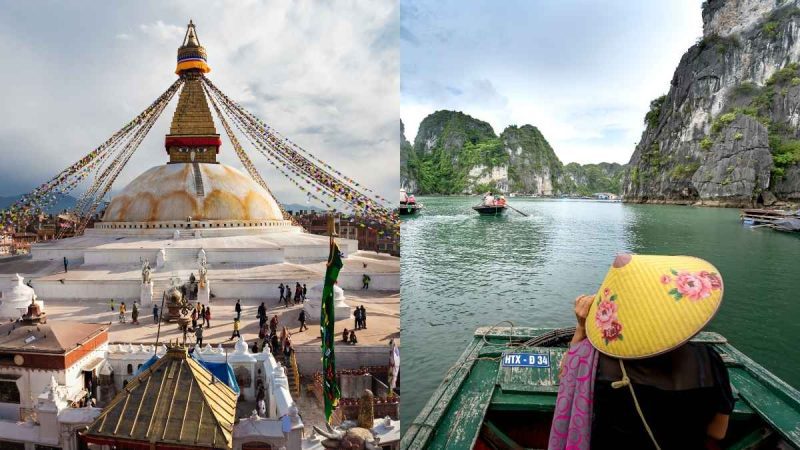Asia is a treasury of viewer delights. It boasts of empires, folds prayers into alleyways, and lets mountains and jungles argue with each other in thunder and silence. These UNESCO World Heritage Sites across Asia aren’t museum pieces; they’re living pieces of history. They dare you to stop scrolling and really stand still. With World Tourism Day looming, six of them refuse to be ignored.
6 World Heritage Sites Across Asia
1. Angkor Archaeological Park
Drive out of Siem Reap, and Angkor doesn’t appear so much as it ambushes you. Angkor Wat is the obvious star, with walls chiselled with wars and gods so precise you start wondering if stone once breathed. But stay longer and Bayon Temple holds your attention, it boasts of dozens of serene faces of Gods. And then there’s Ta Prohm, where tree roots throttle temples like nature’s overgrown graffiti. Built in the late 12th century during the reign of Jayavarman VII, this temple was originally a Buddhist monastery and university. What sets Ta Prohm apart in the list of world heritage sites across Asia is its preservation in a “semi-ruined” state.
2. Ha Long Bay, Vietnam
Ha Long Bay in northern Vietnam is renowned for its dramatic seascape of jagged limestone islands rising sharply from emerald waters, often shrouded in mist. The bay’s unique karst formations create a striking visual experience, complemented by local fishing communities and opportunities for kayaking through hidden caves. Recognised as a UNESCO World Heritage Site of Asia, Ha Long Bay offers visitors an immersive natural environment that highlights cultural heritage.
3. Borobudur Temple, Indonesia
In Central Java, Borobudur blossoms. It boasts nine stacked terraces, petals of a lotus sculpted in stone, and more than 500 Buddhas sitting in silence as if waiting for you to hush up. Walk the reliefs slowly and it’s not sightseeing anymore, it’s a pilgrimage in miniature. By the time you reach the top of this world heritage site in Asia, you’re not climbing a temple; you’re climbing into someone else’s thousand-year-old prayer.
4. Ayutthaya, Thailand
Once Siam’s glittering capital, now Ayutthaya stretches out in stupas and decapitated Buddhas. Sunlight slices through crumbling arches, and stray dogs nap where kings once plotted. You think you’re walking ruins until you feel the quiet pressing back. Ayutthaya isn’t gone. Its heritage is wrapped in history, proving that collapse can still be majestic.
5. Kathmandu Valley, Nepal
Kathmandu Valley doesn’t just exist, it thrums like a drum you can’t ignore. Hindu bells clang against Buddhist horns, incense tangles with street dust, and Durbar Squares spill over with rickshaws, pigeons, and centuries stacked like bricks. At Swayambhunath, prayer flags shred themselves into ribbons against the wind, marking time in a way clocks can’t. At Pashupatinath, spiritual life and spectacle entangle into a beautiful experience.
6. Ajanta Caves, Maharashtra
Sitting in a cliffside in Maharashtra, the Ajanta Caves are less like a museum and more like a time machine, whisking visitors back two millennia. Here, Buddhist monks once chanted under flickering oil lamps, while walls came alive with stories of the Lord Buddha and his previous lives. Each cave has its own personality here, with intricate carvings of dancing figures and elephants frozen mid-step. It’s not just art, it’s a slice of life.
These five places are not just postcard stops. From Cambodia’s jungle to Vietnam’s waters, shift moods, from Java’s lotus stone to Thailand’s ruins and Nepal’s valley, they become part of the memory of world heritage sites across Asia once you travel to them.
Cover Image Courtesy: quangnguyen/CanvaPro and andrey/CanvaPro
For more such snackable content, interesting discoveries and the latest updates on food, travel and experiences in your city, download the Curly Tales App. Download HERE.

